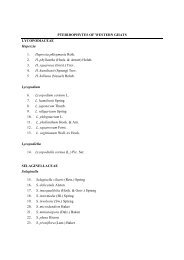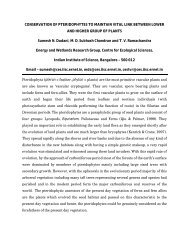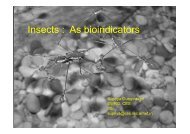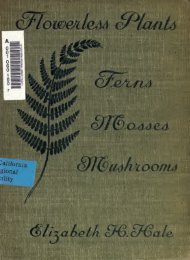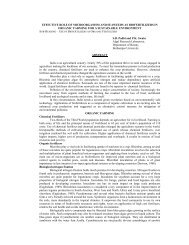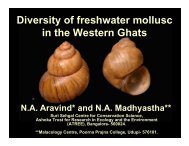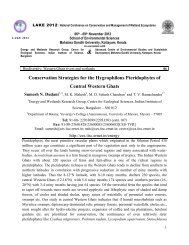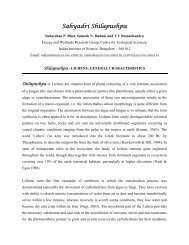Myristica Swamps of the Western Ghats -Sameer Ali
Myristica Swamps of the Western Ghats -Sameer Ali
Myristica Swamps of the Western Ghats -Sameer Ali
You also want an ePaper? Increase the reach of your titles
YUMPU automatically turns print PDFs into web optimized ePapers that Google loves.
Faunal assemblages in <strong>Myristica</strong> swamps<br />
<strong>of</strong> Central <strong>Western</strong> <strong>Ghats</strong>, <strong>Ghats</strong>,<br />
Karnataka, India<br />
SAMEER ALI<br />
Energy and Wetlands Research Group<br />
Centre for Ecological Sciences<br />
Photo Karthick B
What are <strong>Swamps</strong>?<br />
<strong>Swamps</strong> are wetlands dominated by<br />
woody plants. They have fairly deep<br />
water and minimal growth <strong>of</strong><br />
emergent plants.<br />
<strong>Swamps</strong> have a high water table and<br />
occur near rivers, streams, and lakes.<br />
The soils are saturated (or soaked)<br />
with water. The soil is thick, black,<br />
and nutrient-rich nutrient rich providing an<br />
environment for water tolerant trees<br />
and o<strong>the</strong>r organisms.<br />
Typical swamp dominated by Mastixia<br />
arborea and Hydnocarpus laurifolia
Freshwater swamps occur in many<br />
parts <strong>of</strong> <strong>the</strong> world.<br />
Valleys <strong>of</strong> Mississippi and its<br />
tributaries, in Sweden, Odzala<br />
National Park, Congo, in <strong>the</strong><br />
Malaysian region, Papua New<br />
Guinea, etc.<br />
Swamp forests fringe <strong>the</strong> Amazon<br />
and its tributaries<br />
In India, freshwater swamps are<br />
reported from <strong>the</strong> Siwalik and Doon<br />
Valley and <strong>the</strong> Brahmaputra Valley<br />
(Rao Rao, , 1994).<br />
Green anaconda (Eunectes murinus) from<br />
<strong>the</strong> <strong>Swamps</strong> <strong>of</strong> Venezuela
What are <strong>Myristica</strong> <strong>Swamps</strong>?<br />
These are Freshwater swamps dominated by <strong>Myristica</strong>ceae members (Nutmeg<br />
family).<br />
<strong>Myristica</strong>ceae, <strong>Myristica</strong>ceae,<br />
a primitive family <strong>of</strong> trees.<br />
<strong>Myristica</strong> swamps in <strong>Western</strong> <strong>Ghats</strong><br />
Krishnamoorthy (1960) reported for <strong>the</strong> first time from <strong>the</strong> Travancore region <strong>of</strong><br />
Sou<strong>the</strong>n <strong>Western</strong> <strong>Ghats</strong>. <strong>Ghats</strong><br />
Atlas <strong>of</strong> Endemics <strong>of</strong> <strong>the</strong> <strong>Western</strong> <strong>Ghats</strong> (India), by Ramesh and Pascal (1997), provide<br />
<strong>the</strong> distribution maps <strong>of</strong> <strong>Myristica</strong> fatua and Gymnacran<strong>the</strong>ra canarica , trees exclusively<br />
associated with <strong>the</strong> <strong>Myristica</strong> swamps.
Recent work in Uttara Kannada district <strong>of</strong> central <strong>Western</strong> <strong>Ghats</strong> (Chandran Chandran<br />
et al ., 1999; Chandran and Mesta, Mesta,<br />
2001) reported <strong>the</strong> presence <strong>of</strong> <strong>the</strong>se<br />
swamps.<br />
The nor<strong>the</strong>rnmost swamp known is associated with a sacred grove in in<br />
<strong>the</strong><br />
Satari taluk <strong>of</strong> Goa (Santhakumaran<br />
Santhakumaran et al. 1995).<br />
The dominant tree species found in <strong>the</strong> <strong>Myristica</strong> swamps are, Gymnacran<strong>the</strong>ra<br />
canarica, canarica,<br />
Semecarpus travancorica, travancorica,<br />
<strong>Myristica</strong> fatua var. magnifica, magnifica,<br />
Mastixia arborea etc.
Characteristic features<br />
Flooded and water logged conditions are<br />
not conducive for most plants and require<br />
special kinds <strong>of</strong> adaptations. (as in case <strong>of</strong><br />
Mangrooves).<br />
Mangrooves).<br />
Simillarly swamp species also undergone<br />
ceratain modifications<br />
Root modification<br />
Aerial adventitious roots called stilt roots<br />
that spring out from <strong>the</strong> main trunk<br />
provide additional support to <strong>the</strong> swamp<br />
trees in <strong>the</strong> s<strong>of</strong>t soil.<br />
Such roots might become woody and<br />
flattened with age, becoming ‘flying<br />
buttresses' as in <strong>Myristica</strong> spp. spp<br />
Apart from <strong>the</strong> <strong>Myristica</strong>s, <strong>Myristica</strong>s,<br />
<strong>the</strong> several flood<br />
tolerant species <strong>of</strong> <strong>the</strong> <strong>Western</strong> <strong>Ghats</strong>, such<br />
as Elaeocarpus, Elaeocarpus,<br />
Holigarna, Holigarna,<br />
Madhuca neerifolia, neerifolia,<br />
Pandanus etc. also produce stilt roots.<br />
Stilt roots <strong>of</strong> <strong>Myristica</strong> fatua<br />
var. magnifica
Some <strong>of</strong> <strong>the</strong> trees has knee roots which<br />
protrude out <strong>of</strong> <strong>the</strong> swampy soil all around<br />
<strong>the</strong> tree.<br />
At least initially <strong>the</strong> knees are spongy and<br />
apparently provide <strong>the</strong> underwater roots<br />
with air.<br />
The knees facilitate gas exchange freely<br />
(Cowles, 1975). Pond cypress in <strong>the</strong> US and<br />
Semecarpus sp., have such knee roots.<br />
Some species like, Gymnacran<strong>the</strong>ra canarica has<br />
loop like roots protrude into <strong>the</strong> air from <strong>the</strong><br />
flooded substratum in <strong>the</strong> swamp.<br />
These aerial loops, which thicken with age,<br />
are studded with enlarged air pores called<br />
lenticels.<br />
Knee roots <strong>of</strong> Semicarpus<br />
kathalekanensis<br />
Knee roots <strong>of</strong> Gymnacran<strong>the</strong>ra<br />
canarica
Rhizomes<br />
Rhizomes are thick stems buried in <strong>the</strong><br />
soils as found in many herbaceous<br />
plants such as ginger, turmeric etc.<br />
Many swamp growing ferns and herbs<br />
such as aroids have spongy rhizomes.<br />
Pinanga dicksonii, dicksonii,<br />
a delicate, shade-loving shade loving<br />
palm endemic to <strong>the</strong> <strong>Western</strong> <strong>Ghats</strong>,<br />
and <strong>of</strong>ten found in <strong>the</strong> vicinity <strong>of</strong> <strong>the</strong><br />
<strong>Myristica</strong> swamps, propagate mainly<br />
through rhizomes.<br />
Pinanga<br />
Rhizomes, according to Braendle and<br />
Crafford (1987), exhibit a much greater<br />
range <strong>of</strong> flood tolerance than roots. Pinanga dicksonii<br />
Photo K V Gururaja
o<br />
74.170<br />
Study area<br />
The study has been carried out in <strong>the</strong> five <strong>Myristica</strong><br />
swamps <strong>of</strong> Honnavar and Siddapur taluk, taluk,<br />
Uttara<br />
Kannada district <strong>of</strong> central <strong>Western</strong> <strong>Ghats</strong>.<br />
<strong>Ghats</strong><br />
o<br />
14.569<br />
Arabian Sea<br />
Aghanashini river<br />
Sharavathi river<br />
Venkatapura river<br />
Halsolli<br />
Torme Mundigethaggu<br />
Malemane<br />
Kathalekan<br />
0 10<br />
kilometers<br />
20<br />
13.934 o<br />
74.922<br />
o<br />
%
The Uttara Kannada district, formerly North Kanara (13°52" to 15°30"N and<br />
74°05" to 75°5"E), is located towards <strong>the</strong> centre <strong>of</strong> <strong>the</strong> <strong>Western</strong> <strong>Ghats</strong>. <strong>Ghats</strong>.<br />
The district with 10,250 km² <strong>of</strong> area is one <strong>of</strong> <strong>the</strong> most forested in South India<br />
with about 70% <strong>of</strong> <strong>the</strong> land under forest cover, including forest plantations.<br />
Here <strong>the</strong> <strong>Western</strong> <strong>Ghats</strong> seldom exceeds 700m in altitude. The district is a<br />
maze <strong>of</strong> steep hills with narrow valleys. Tropical evergreen to semi semi-evergreen<br />
evergreen<br />
forests form <strong>the</strong> natural climax vegetation in most <strong>of</strong> parts <strong>of</strong> <strong>the</strong> <strong>the</strong><br />
district,<br />
which receive 200 to 500cm <strong>of</strong> rainfall.
Myriatica swaps - floral diversity<br />
The swamp has high level <strong>of</strong> <strong>Western</strong> Ghat endemism among plants.<br />
A total <strong>of</strong> 64 tree species are enumerated from <strong>the</strong> five <strong>Myristica</strong> swamps. <strong>the</strong><br />
dominant tree species are, Gymnacran<strong>the</strong>ra canarica, canarica,<br />
Semecarpus kathalekanensis,<br />
kathalekanensis,<br />
<strong>Myristica</strong> fatua var. magnifica, magnifica,<br />
Mastixia arborea etc.<br />
Apart from this 24 species <strong>of</strong> shrubs and herbs (which include 8 species <strong>of</strong><br />
Pteridophytes) Pteridophytes)<br />
also found in <strong>the</strong> swamps.
The <strong>Myristica</strong> swamps are also associated with many o<strong>the</strong>r species which show<br />
tolerance to various degrees <strong>of</strong> flooding. However <strong>the</strong>se are not swamp exclusive<br />
species.<br />
Among <strong>the</strong> trees, evergreens like Calophyllum apetalum, apetalum,<br />
Dipterocarpus indicus, indicus,<br />
Elaeocarpus tuberculatus, tuberculatus,<br />
Lophopetalum wightianum and Mastixia arborea. arborea.<br />
Recently one species also described from <strong>the</strong> <strong>Myristica</strong> swamps <strong>of</strong> Uttara<br />
Kannada Semecarpus kathalekanensis (Swaminath Swaminath, , 2000).<br />
Notable <strong>of</strong> <strong>the</strong> ground layer are herbs like Alpinia malaccensis, malaccensis,<br />
Jerdonia indica, indica,<br />
Neurocalyx calycinus and Schumanniatus virgatus. virgatus.<br />
An aroid Lagenandra ovata and Elatostemma lineolatum and Pellionia heyneana, heyneana,<br />
both<br />
members <strong>of</strong> Urticaceae, Urticaceae,<br />
are abundantly associated with <strong>the</strong> swamps.<br />
The Pteridophytes are Angiopteris evecta, evecta,<br />
Bolbitis appendiculata, appendiculata,<br />
Cya<strong>the</strong>a nilgiriensis, nilgiriensis,<br />
Osmunda regalis, regalis,<br />
Pronephrium triphyllum, triphyllum,<br />
Pteris, Pteris,<br />
Staenochlaena palustris and Tectaria<br />
wigthii.<br />
wigthii
<strong>Myristica</strong> diversity<br />
swamps - faunal<br />
These swamps also harbour many<br />
endemic and endangered fauna <strong>of</strong><br />
<strong>the</strong> <strong>Western</strong> <strong>Ghats</strong>. <strong>Ghats</strong>.<br />
About six species <strong>of</strong> damselflies<br />
including Phylloneura westermanni, westermanni,<br />
which is a range extension from<br />
Coorg and Wayanad (Fraser, 1933).<br />
O<strong>the</strong>r species are, Clear-winged<br />
Clear winged<br />
Forest glory (Vestalis ( Vestalis gracilis), gracilis),<br />
Malabar torrent dart (Euphea ( Euphea fraseri), fraseri),<br />
Stream ruby (Rhinocypha ( Rhinocypha bisignata), bisignata),<br />
Black-tipped Black tipped forest glory (Vestalis ( Vestalis<br />
apicalis) apicalis)<br />
and Pied reed tail (Protosticta ( Protosticta<br />
gravelyi) gravelyi)<br />
Malabar torrent dart (Euphea ( Euphea fraseri) fraseri
109 species <strong>of</strong> butterflies<br />
representing five families are<br />
found in <strong>the</strong> <strong>Myristica</strong><br />
swamps<br />
Family Nymphalidae is<br />
dominated by 43 species.<br />
Papilionidae 16 species,<br />
Pieridae 13, Lycaenidae 18<br />
and Hesperiidae 19 species.<br />
About 16 species <strong>of</strong> fishes.<br />
Garra gotyla stenorhynchus, stenorhynchus,<br />
Rasbora daniconius, daniconius,<br />
Danio<br />
aequipinnatus are prominent<br />
species.<br />
Garra<br />
Malabar tree nymph (Idea ( Idea malabarica) malabarica<br />
Common Pierrot<br />
(Castalius Castalius rosimon) rosimon
About 29 species <strong>of</strong> amphibians are<br />
listed from <strong>the</strong> five <strong>Myristica</strong> swamps.<br />
Order Anura comprises eight families<br />
and Gymnophiona <strong>the</strong> family<br />
Ichtyophiidae.<br />
Ichtyophiidae.<br />
The family Dicroglossidae and<br />
Rhacophoridae species each.<br />
comprises seven<br />
Whereas <strong>the</strong> family Nyctibatrachidae<br />
and Ranidae comprises three species<br />
each.<br />
Some <strong>of</strong> <strong>the</strong> notable species are,<br />
Micrixalus saxicola Nyctibatrachus major, major,<br />
N. . petraeus Philautus ponmudi, ponmudi,<br />
P. P.<br />
neelanethrus, neelanethrus,<br />
Polypedatus pseudocruciger and<br />
Rhacophorus malabaricus. malabaricus.<br />
Rhacophorus malabaricus<br />
Nyctibatrachus petraeus<br />
Philautus ponmudi<br />
Photo Samer <strong>Ali</strong>, K V<br />
Gururaja
59 species <strong>of</strong> birds found in<br />
<strong>the</strong>se swamps.<br />
Wynaad laughing thrush<br />
(Garrulax Garrulax delesserti), delesserti),<br />
Great pied<br />
hornbill (Buceros ( Buceros bicornis), bicornis),<br />
Bluewinged parakeet (Psittacula ( Psittacula<br />
columboides) columboides<br />
22 species <strong>of</strong> reptiles which<br />
includes 13 species <strong>of</strong> snakes.<br />
Calotes rouxii<br />
Calotes sp.<br />
Cnemaspis sp.
The notable snakes are King cobra<br />
(Ophiophagus Ophiophagus hannah), hannah),<br />
Humpnosed pit<br />
viper (Hypnale ( Hypnale hypnale), hypnale),<br />
Malabar pit viper<br />
(Trimersurus Trimersurus malabaricus), malabaricus),<br />
Trinket snake<br />
(Elaphe Elaphe helena helena) helena)<br />
etc.,<br />
Humpnosed pit viper (Hypnale ( Hypnale hypnale) hypnale<br />
Malabar pit viper (Trimersurus ( Trimersurus malabaricus) malabaricus<br />
Photo Samer <strong>Ali</strong> & K V Gururaja
About 15 species <strong>of</strong> mammals found in<br />
<strong>the</strong>se swamps, which include an endemic<br />
and endangered primate Lion tailed<br />
macaque (Macaca ( Macaca silenus). silenus).<br />
Lion-tailed Lion tailed Macaque, an endangered<br />
primate <strong>of</strong> <strong>the</strong> <strong>Western</strong> <strong>Ghats</strong>, <strong>Ghats</strong>,<br />
is associated<br />
with <strong>the</strong> relics <strong>of</strong> <strong>the</strong> primary forests in<br />
Siddapur having <strong>the</strong> <strong>Myristica</strong> swamps and<br />
Dipterocapus. Dipterocapus.<br />
Lion tailed macaque (Macaca ( Macaca silenus) silenus
Ecological value<br />
<strong>Swamps</strong> have Watershed value, Because <strong>the</strong> bottom <strong>of</strong> <strong>the</strong> swamp is at or below<br />
<strong>the</strong> water table, it serves to channel run<strong>of</strong>f into <strong>the</strong> groundwater groundwater<br />
supply, helping<br />
to stabilize <strong>the</strong> water table.<br />
During periods <strong>of</strong> very heavy rains, a swamp can act as a natural flood control<br />
device (Columbia ( Columbia Encyclopaedia, Encyclopaedia,<br />
1978)<br />
Standing or slow moving water seeps continuously into <strong>the</strong> ground, ground,<br />
helping to<br />
replenish underground water reservoirs called acquifers (Cunningham and Saigo, Saigo,<br />
1990).<br />
The presumed widespread loss <strong>of</strong> perennial freshwater swamps such as <strong>the</strong><br />
<strong>Myristica</strong> swamps, as evidenced by <strong>the</strong>ir present day rarity and fragmentation fragmentation<br />
is<br />
perhaps a reminder <strong>of</strong> <strong>the</strong> progressive desiccation <strong>of</strong> <strong>the</strong> <strong>Western</strong> <strong>Ghats</strong>.
The swamp and its immediate surrounding forests have a<br />
number <strong>of</strong> wild fruit bearing trees.<br />
These include Garcinia, Garcinia,<br />
<strong>Myristica</strong>, <strong>Myristica</strong>,<br />
Syzygium, Syzygium,<br />
Holigarna, Holigarna,<br />
members <strong>of</strong><br />
Lauraceae, Lauraceae,<br />
Meliaceae, Meliaceae,<br />
Myrtaceae etc. which provide food for<br />
many wild mammals and birds. birds<br />
.
Threats to <strong>Myristica</strong> swamps in<br />
study area<br />
In <strong>the</strong> study area most swamps are<br />
presumably extinct due to human<br />
impacts <strong>of</strong> various kinds.<br />
The swamps are encroached for<br />
agricultural lands and areca plantations.<br />
The two <strong>of</strong> <strong>the</strong> studied swamps are at<br />
risk <strong>of</strong> disapearence due to areca<br />
plantations.<br />
The pressure is mounting on <strong>the</strong> last<br />
traces <strong>of</strong> <strong>the</strong> remaining swamps, due to<br />
mainly ignorance about <strong>the</strong> value and<br />
evolutionary significance <strong>of</strong> <strong>the</strong>se<br />
ancient patches <strong>of</strong> forests.<br />
Palynological studies might be <strong>of</strong> help<br />
in locating some <strong>of</strong> <strong>the</strong> past swamps.<br />
Encroachment in <strong>the</strong><br />
Kathalekan <strong>Myristica</strong> swamps
Conservation<br />
The <strong>Myristica</strong> swamps in this region are in <strong>the</strong> verge <strong>of</strong> extinction due to<br />
rampant illegal conversions to agricultural lands and areca plantations. plantations.<br />
Rich biodiversity <strong>of</strong> swamps along with <strong>the</strong> evolutionarily significance significance<br />
demands<br />
<strong>the</strong> immediate policy measures to conserve <strong>the</strong>se <strong>Myristica</strong> swamps— swamps fragile<br />
ecosystems in remnant forest patches <strong>of</strong> Uttara Kannada.<br />
Special efforts should be made to locate more <strong>of</strong> <strong>the</strong>se swamps lying lying<br />
hidden in<br />
<strong>the</strong> recesses <strong>of</strong> <strong>the</strong> <strong>Western</strong> <strong>Ghats</strong>.
Semicarpus kathalekanensis patch in Kathalekan swamp<br />
T<br />
H<br />
A<br />
N<br />
K<br />
S<br />
Photo Samer <strong>Ali</strong>



